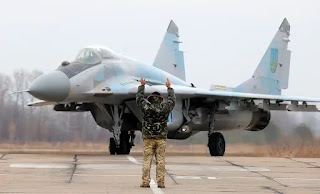US Person has stayed largely quiet about the counter-offensive by Ukraine as requested, but a tactical gap in their operations is just too obvious to ignore. It can be summed up in one question: where is their close air support? Ground forces are making some incremental gains against an enemy that is learning from its prior mistakes and is entrenched against most axis of advance. Ukraine cannot expect to advance rapidly unless they have close air support to oppose a formidable Russian combination of artillery, attack helicopters, and mines.
Attack 'copters like the K-52 Alligator,
[photo credit: Getty Images] familiar to western observers by its counter-rotating twin rotors, are focusing on taking out Ukrainian engineering vehicles needed to clear a path for armor through the mine fields. Ukraine cannot afford to loose too many of these vehicles. And
apparently it cannot oppose the Russian aircraft due to
a shortage of short-range air defense systems (SHORAD). The Russian helicopters are firing from long range, putting them out of reach of MANPADs (Stinger: 4800m).
Bunched up behind the mine clearing operations, Ukraine's armor and infantry is vulnerable to artillery barrages. This tactical situation explains what is going on around Tokmak where the counter-offensive has slowed down.
Armchair generals are a dime a click nowadays. So
US Person feels he can make a suggestion. He is aware that Ukrainian Air Force assets are limited, but the need for front-line combat air patrols is become more and more critical to success. In the absence of mobile SHORAD systems such as the infamous BUK-M1 (SA-11)* that was used to shoot down Malaysian Airliner Flt 17, fearless hot-sticks need to jump into their MiGs
[left photo credit:AP] and fly near the front to be vectored to targets called in by ground forces under attack or by front-line tactical radar and drone operators. Suppressing Russian air attacks and artillery using long-range missiles and glide bombs would be the goal. Granted, aging Fulcrums have notable disadvantages, but should be able to easily defeat attack helicopters. Neither side has significant air superiority, but the Russians seem more willing to risk aircraft and pilots because they have more of both. This gives them a tactical advantage on the battlefield.
The situation around Velyka Novosilka is nevertheless promising for Ukraine. They need to advance just 10 more miles to reach Staromlynivka; easy to say when you are not suffering under an artillery barrage. Ground forces would be behind most of Russian fortified defense lines, which are relatively thin in this area, just south of the town. A path to Mariupol, which US Person suggested should be a goal of the offensive, would then be open for Ukrainian maneuver across flat farm fields north of Nadine village. The east-west rail line could be cut either at Polohy or Zachativka. Reaching the sea at Mariupol or Berdyansk would doom Russian forces in the southeast since their supply lines would be cut off, and Crimea would be in range of missile attack. At some point Ukraine will need to interdict the Black Sea feet to prevent resupply by ship and to eliminate cruise missile attacks on its cities. Thank you for your attention and now, back to our regularly scheduled war. Slava Ukraini!
*Finland, now a member of NATO, reportedly has some of these SA-11 systems in storage. The US could offer to replace these with Patriot or HAWK-21 systems, if Finland gifted them to Ukraine.

